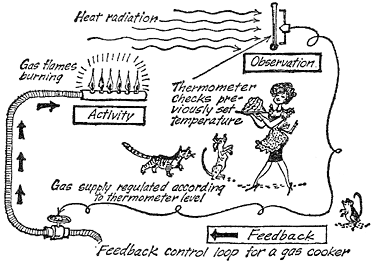Feed-Backs
On the other hand, there have been computers in existence for many years which master a primitive kind of "learning by success," pinpointed in a single direction, and make profitable use of it. But elementary learning devices of such a kind exist entirely outside the realm of electronics. You too have certainly often had occasion to deal with them. Think of the automatic apparatus for keeping baking-temperature constant in your oven. Or of the mechanism which switches on the refrigerator motor when the temperature rises more than it should. Or of the thermostat which starts up the central heating as soon as the temperature in the living room falls below 65 degrees.

Illus. 46.
All these devices work on the "feed-back" principle. The temperature regulator in the gas range switches the heat on. Then it observes what happens in consequence. Its observations react on the functions of the gas burners; they are "fed back." If it is too hot, the heat is throttled. If the temperature drops below the set figure, the heating elements turn themselves on again. This system of circulation - activity, observation, feed-back, activity - has a special name: it is called a "feed-back control loop" because such a system is capable of regulating or controlling its own activity.
Computers which carry on an elementary kind of "learning by success" with the aid of control loops and feed-back are often utilized today. Strictly speaking, they are merely beginning to try to learn, by making preliminary experiments. They hold aircraft and ships to their predetermined courses by keeping an eye on the compass and levelling out deviations from the true route by correcting the steering gear. They check the dilution of chemical solutions, regulate atmospheric humidity or exposure time in automatic photographic enlargers, and in automated factories they take the place of the head controller.
You probably know that many plants in the chemical and metal-processing industries operate nowadays practically without any workers. Machines attend to what must be done - whether it is a matter of drilling holes correctly dimensioned to twenty-five-thousandths of an inch, tapping screw threads or polishing surfaces, pulverizing chemical substances, weighing, mixing or shaking them, pouring them into bottles, pressing the cork in and sticking the label on. Machines are better workers than men in many ways. They are faster, more reliable, not interested in the manager's typist and never go on strike for higher pay. But - and in this they are like human beings - they are still not 100% dependable. Their production has to be checked just like the work of human beings.
©
by PhiloPhax & Lauftext
& Redaktion Lohberg
Kybernetik
- Was ist das?
First printed in Germany: 1963